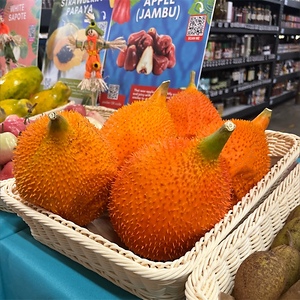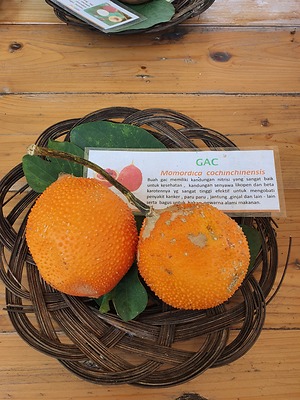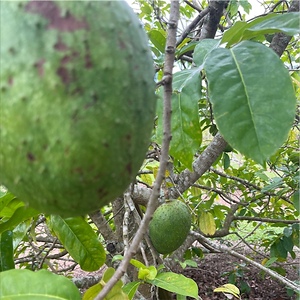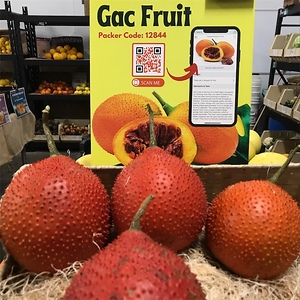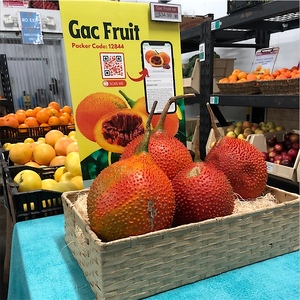

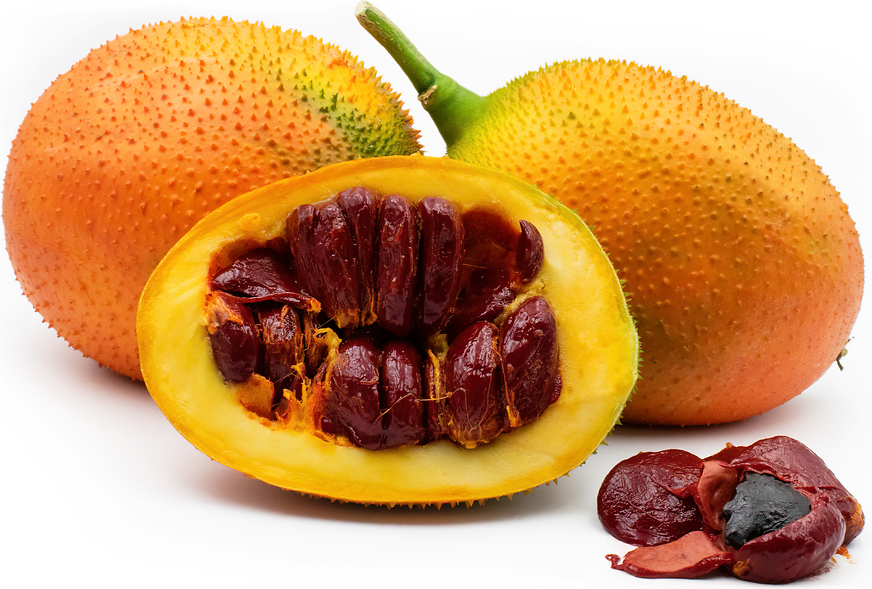
Gac Fruit
Estimated Inventory, ea : 0
This item was last sold on : 10/08/24
Description/Taste
Gac fruits are small to medium in size, averaging 11 to 13 centimeters in length and 8 to 10 centimeters in diameter, and have a round to oblong, curved shape. The skin, sometimes labeled as the rind, is semi-thin and covered in small spikes and protrusions, developing a coarse and leathery texture. The fruits are dark green when unripe, transitioning into yellow, orange, to red-orange hues with maturity. Underneath the surface is a dense layer of creamy orange to yellow flesh, known as the mesocarp, that ranges from 2 to 3 centimeters in thickness. The flesh encases a central chamber filled with 15 to 20 seeds wrapped in dark red membranes. The crimson arils are the edible portion of the fruit and have a soft, slippery, melting texture. The arils also often have a glistening appearance due to their high oil content, contributing to the fatty, buttery texture. When the membranes are removed, a white to dark brown flat seed is revealed with jagged edges. Gac fruits release a faint, pumpkin or squash-like aroma when opened and should be consumed raw only when ripe. The fruits are naturally firm before they mature, and as they change in color and ripen, the flesh will become soft and squishy. When ripe, Gac fruits have a very mild, neutral flavor that is sometimes regarded as vegetal and bland when served by itself. If the arils are cooked, they become slightly more savory with a rich but mild taste. Gac fruits are primarily combined with other ingredients for improved flavoring.
Seasons/Availability
Gac fruits are available for a short season, typically in the mid-winter through early spring.
Current Facts
Gac fruits, botanically classified as Momordica cochinchinensis, are a rare, seasonal fruit belonging to the Cucurbitaceae family. The brightly colored fruits grow on tropical, climbing vines that extend over six meters in length, winding over trellises, lattices, trees, and other sturdy structures. The fruits are native to Southeast Asia, specifically Vietnam, and were selected for small-scale cultivation for their nutritional properties and natural coloring. Gac fruits are commonly planted in home gardens and ripen for a very short season, fruiting for about two months each year. One Gac fruit vine can produce anywhere from 30 to 60 fruits per season, but often the vines must be hand pollinated to ensure fruiting, as the species is dioecious in nature, meaning there are separate male and female plants. The fruits must also only be picked when ripe, and once mature, the fruits quickly soften and expire, making them challenging to ship outside of their native habitats. Gac fruit is nicknamed the "heavenly fruit" in Vietnam for its upward climbing nature and high nutritional content, and the name Gac is derived from a Vietnamese name translating to mean "round." The fruits have acquired several regional names throughout Southeast Asia, including Cochinchin gourd, Fahk Khao, Bhat Karela, Cundeamor, Red melon, Sweet gourd, Taw Thabu, Trai Gac, and Qua Gac. Historically, Gac fruits were rarely known outside of Southeast Asia, but in the present day, Gac fruits have been receiving worldwide recognition over social media platforms for their unusual, brilliant red coloring. Gac fruits are primarily incorporated into natural medicines and celebratory culinary preparations.
Nutritional Value
Gac fruits are known for their high lycopene and beta-carotene content. Lycopene is a natural compound or carotenoid that contributes to the fruit's dark red and orange coloring. This compound has antioxidant-like properties to protect the cells in the body against the damage caused by free radicals. Some studies indicate that Gac fruits contain seventy times more lycopene than tomatoes. Beta-carotene also adds to the fruit's coloring and is converted into vitamin A in the body to maintain healthy organ functioning. It is believed that Gac fruits contain ten times more beta-carotene than sweet potatoes or carrots. In natural medicines, Gac fruits are also valued for their omega-3 fatty acids, vitamins D, E, and K, and linoleic acid content. Traditional Chinese Medicine uses Gac fruit arils to assist in healing burns, eye issues, and skin grievances. The seeds, known as mu bie zie or "wooden turtle seeds," are also roasted and incorporated into medicinal remedies. Outside of natural medicines, the arils have been added to dietary supplements and juices, and the oil from the arils is pressed and sold in health stores.
Applications
The most common portion of Gac fruit utilized for culinary applications is the fleshy red arils surrounding the seeds. These crimson arils can be eaten straight out of hand, but their oily texture and neutral flavor are not typically enjoyed on their own. Gac fruit arils are more popularly deseeded and cooked into a paste with sugar, oil, and salt. This paste is mixed with glutinous rice to add color and a subtle flavoring. In Vietnam, Gac fruit paste is steamed into rice, sticky rice cakes, and dumplings known as banh Gac. The dumplings are shaped into bright red round balls or are flattened, wrapped in banana leaves, and steamed, a specialty dish created in the Ninh Giang District of Hai Dong Province in Northern Vietnam. Gac fruit paste can also be incorporated into sauces with tomatoes and served as an addition to soups, grilled seafood, stews, and even as an unconventional pizza or pasta sauce. In Thailand, Gac fruit arils are served with ice cream or stirred into baked goods as a natural coloring. The arils are also boiled and blended into juices or smoothies with other fruits for added flavor. Beyond the arils, some communities in India and Sri Lanka consume the yellow flesh surrounding the arils in curries. It has also been reported that young fruits are cooked like vegetables in some Indian dishes, removing the spikey skin before use. The fruit's flesh is heavily debated as some sources claim the yellow flesh is inedible, while others claim the flesh is edible. More research should be done before eating the yellow flesh, but it is known that the red arils are safe for consumption. In addition to the fruits, the young shoots and leaves of the Gac vine are eaten as a vegetable in Southeast Asia, often served with chili-based condiments for enhanced flavor. Gac fruits are cooked with aromatics such as garlic, ginger, or onions, tomatoes, potatoes, squash, or blended with fruits including pineapple, coconut, and passion fruit. Whole, unopened Gac fruits should be immediately consumed when ripe for the best quality and flavor. Extracted arils may keep for 1 to 2 days when stored in a sealed container in the refrigerator, but the fruits are highly perishable. Gac fruit arils are also dried and ground into a powder for extended use. The powder can be made through freeze-drying, air-drying, or vacuum-drying.
Ethnic/Cultural Info
Gac fruits are a special culinary ingredient intertwined into the traditions and cultural practices of Tet, the Vietnamese New Year. Tet is an abbreviation for Tet Nguyen Dan, meaning "the first morning of the first day of the New Year." The celebration lasts anywhere from 5 to 7 days in Vietnam and is considered one of the most important festivals of the year, ushering in spring and a fresh start. During Tet, families return home, clean their houses, and decorate spaces with kumquat trees, peach and apricot blossoms, and gold and red items, symbolically welcoming blessings of prosperity for the year to come. On New Year's Day, communities hold parades, light firecrackers, and bang drums to ward off evil spirits. After the festivities, families host elaborate meals with traditional dishes. Gac fruit is incorporated into xoi gac, a glutinous rice dish molded into shapes and served with a specialty Vietnamese ham. Xoi gac is comprised of Gac fruit arils cooked into a paste with cinnamon, sugar, and salt and then stirred into rice to give the dish a red hue. The color red is believed to bring promises of longevity, luck, and wealth in the coming year, and consuming red culinary dishes is said to bless the household.
Geography/History
Gac fruits are native to Southeast Asia, and experts point to Vietnam as the center of origin. The fruits have been growing wild since ancient times, and the species name, cochinchinensis, is derived from the Cochinchina region in southern Vietnam. The vines thrive in warm, tropical climates with ample sun and rainfall and naturally climb on trees along riverbanks and forest edges. In cultivation, Gac vines are found on support structures such as trellises, fences, and walls. It is unknown when Gac fruit was spread across Southeast Asia, but there are records from the 15th century documenting its use in natural medicines in China. Gac fruits were also introduced to select tropical regions worldwide as a novelty. Today Gac fruits are rare and primarily found in their native growing regions throughout Southeast Asia. The fruits are present in China, Vietnam, Thailand, Cambodia, Laos, Myanmar, Malaysia, the Philippines, and Indonesia. They are also grown in northeastern Australia and Florida. Gac fruits are not commercially cultivated and are sold through specialty growers as a seasonal delicacy.
Recipe Ideas
Recipes that include Gac Fruit. One
| Takes Two Eggs |
|
Vietnamese Red Sticky Rice (Xoi Gac) |
| YouTube |
|
Kaeng Som Gac Fruit |
| At My Kitchen Table |
|
Gac Fruit Sticky Rice Cakes |
| YouTube |
|
Gac Fruit Paste |







